Reception~Salad
François Chidaine Montlouis sur Loire
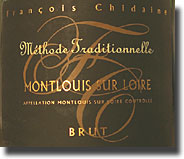 This
medium straw colored wine is made with a mix from
Chidaine’s youngest
Chenin Blanc vines, harvested ripe to avoid any dosage; the natural residual
sugar starts the second fermentation and creates the bubbles. With a good,
active bead, it offers rich, smoky almost cider-like apple flavors and aromas.
Our Chenin-loving buddy Jim Brennan was reminded of an “almost farmhouse ale
kind of thing,” and he had a point. Bubblehead that I’ve become, I could drink
this stuff on a regular basis. Find this wine
This
medium straw colored wine is made with a mix from
Chidaine’s youngest
Chenin Blanc vines, harvested ripe to avoid any dosage; the natural residual
sugar starts the second fermentation and creates the bubbles. With a good,
active bead, it offers rich, smoky almost cider-like apple flavors and aromas.
Our Chenin-loving buddy Jim Brennan was reminded of an “almost farmhouse ale
kind of thing,” and he had a point. Bubblehead that I’ve become, I could drink
this stuff on a regular basis. Find this wine
Phillip’s Spicy Crab Cakes with Butter
(Vegetarian: Paddy’s Pancakes
Crepes with Spinach and Mushroom a la Creme)
2004 Domaine de Roally Mâcon Viré-Clessé
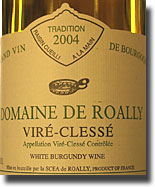 We’ve
loved previous vintages of this one, and it didn’t disappoint in the
least, with lovely perfumed, earthy, stony dry apple and pear character. Subtle,
yet rich and delicious, this has great cut and length and is a testament to
Henri Goyard’s traditional methods: minimal use
of fertilizers and chemical treatments, low yields, manual harvesting late in
the season, bottling a year after the grapes are picked and no oak aging, so
that the fruit shines through on its own. I preferred this with the very tasty
crab cakes, but others commented that the following red worked better for them. Find this wine
We’ve
loved previous vintages of this one, and it didn’t disappoint in the
least, with lovely perfumed, earthy, stony dry apple and pear character. Subtle,
yet rich and delicious, this has great cut and length and is a testament to
Henri Goyard’s traditional methods: minimal use
of fertilizers and chemical treatments, low yields, manual harvesting late in
the season, bottling a year after the grapes are picked and no oak aging, so
that the fruit shines through on its own. I preferred this with the very tasty
crab cakes, but others commented that the following red worked better for them. Find this wine
2005 Domaine des Terres (Jean-Paul Brun) Dorees
Beaujolais l'Ancien Vieilles Vignes
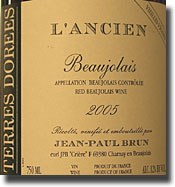 Jean-Paul
Brun is hardly a household name in most wine circles in the US, but
he is an icon to those who are devoted to “real wine.” Our own
Larry Meehan (accompanied by
Jon Cook, Kira Maximovich and
Mike Lawton)
made a pilgrimage to Brun’s doorstep
a few years back, and Joe Dressner was responsible for making the arrangements.
This particular wine comes from 50-70 year old vines planted in limestone soil,
and ferments on indigenous yeasts rather than the industrial 71B stuff that
predominates among far too many producers in Beaujolais. It delivers rich,
earthy flavors and aromas reminiscent of red berries and cherries, with good
structure and a velvet-like texture; not exactly an “iron fist in a velvet
glove,” but it does strike a nice balance. Pure, unadulterated Gamay at its
best; I actually enjoyed this with the following food course. Find this wine
Jean-Paul
Brun is hardly a household name in most wine circles in the US, but
he is an icon to those who are devoted to “real wine.” Our own
Larry Meehan (accompanied by
Jon Cook, Kira Maximovich and
Mike Lawton)
made a pilgrimage to Brun’s doorstep
a few years back, and Joe Dressner was responsible for making the arrangements.
This particular wine comes from 50-70 year old vines planted in limestone soil,
and ferments on indigenous yeasts rather than the industrial 71B stuff that
predominates among far too many producers in Beaujolais. It delivers rich,
earthy flavors and aromas reminiscent of red berries and cherries, with good
structure and a velvet-like texture; not exactly an “iron fist in a velvet
glove,” but it does strike a nice balance. Pure, unadulterated Gamay at its
best; I actually enjoyed this with the following food course. Find this wine
Kenodare Leek, Potato and Cheese Pie
2005 Domaine Thomas-Labaille Sancerre Rouge
Chavignol
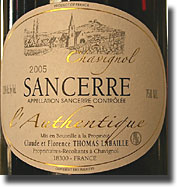 Joe
calls this Loire Pinot Noir “a curiosity and a rarity in America,” and I have to
admit, it’s only the 2nd one I’ve ever tried. It’s not a complex wine, nor is it
intended to be, with middleweight strawberry and tart cherry flavors underscored
with some subtle minerality. Raised in foudre, this is quintessential bistro
wine, being eminently quaffable, although a few tasters were only lukewarm
towards it. Find this wine
Joe
calls this Loire Pinot Noir “a curiosity and a rarity in America,” and I have to
admit, it’s only the 2nd one I’ve ever tried. It’s not a complex wine, nor is it
intended to be, with middleweight strawberry and tart cherry flavors underscored
with some subtle minerality. Raised in foudre, this is quintessential bistro
wine, being eminently quaffable, although a few tasters were only lukewarm
towards it. Find this wine
2005 Claude & Catherine Maréchal Bourgogne Rouge
Cuvée Gravel
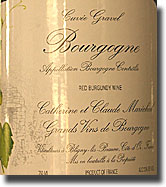 Dressner
says that this wine doesn’t come from a great site, but that the talented
Claude Maréchal
compensates with plowed vineyards, low yields, no sulfur or herbicides being
used and natural fermentation without adding yeast. The intent is to make a wine
with purity of fruit, and in that regard, he has succeeded admirably, because
this is pretty and simply a pleasure to drink, offering earthy, smoky black
cherry flavors and aromas shaded with some hints of underbrush. Already quite
approachable in its youth, this is one to enjoy over the next five years or so. Find this wine
Dressner
says that this wine doesn’t come from a great site, but that the talented
Claude Maréchal
compensates with plowed vineyards, low yields, no sulfur or herbicides being
used and natural fermentation without adding yeast. The intent is to make a wine
with purity of fruit, and in that regard, he has succeeded admirably, because
this is pretty and simply a pleasure to drink, offering earthy, smoky black
cherry flavors and aromas shaded with some hints of underbrush. Already quite
approachable in its youth, this is one to enjoy over the next five years or so. Find this wine
Bandon Beer
Stew
(Vegetarian: Baile Corcaigh Potato Slices with
Chopped Scallions and Grated Irish Cheddar)
2004 Mouthes le Bihan Vieillefont
Côtes-de-Duras
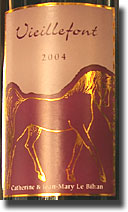 Côtes-de-Duras,
a large appellation with 2200 hectares of vines (5500 acres) could be considered
a satellite of Bordeaux or Cahors, though it makes mostly forgettable wines
targeted for supermarket sales in France. Catherine
and Jean-Mary Le Bihan are apparently among
the exceptions to that rule, as this wine demonstrates. It’s a red Bordeaux
blend from 20 to 30 year old vines with a lot of Malbec in it, aged in oak, but
not new oak. There was some discussion between those seated at our table and the
next as to whether the somewhat funky quality that this displays is due to
Brettanomyces or not, but whatever the case, it is a little poopy when first
poured, with a solid core of earthy black fruit that’s a little bit spicy. It
also pairs well with the beer stew. Find this wine
Côtes-de-Duras,
a large appellation with 2200 hectares of vines (5500 acres) could be considered
a satellite of Bordeaux or Cahors, though it makes mostly forgettable wines
targeted for supermarket sales in France. Catherine
and Jean-Mary Le Bihan are apparently among
the exceptions to that rule, as this wine demonstrates. It’s a red Bordeaux
blend from 20 to 30 year old vines with a lot of Malbec in it, aged in oak, but
not new oak. There was some discussion between those seated at our table and the
next as to whether the somewhat funky quality that this displays is due to
Brettanomyces or not, but whatever the case, it is a little poopy when first
poured, with a solid core of earthy black fruit that’s a little bit spicy. It
also pairs well with the beer stew. Find this wine
Clonakilty Corned Beef and
Cabbage
(Vegetarian: Piperonata Pasta with Grated Irish Cheddar)
2004 Mas Saint-Joseph
Costières-de-Nîmes Cuvée L'Aventure
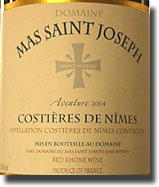 This
Rhône estate is a one-plot, 18 hectares operation that produces Syrah (more than
is common locally), Grenache and Carignan, with vines that average 30 years of
age. It didn’t give me much at all on the nose, although Kim mentioned a little
pine and sweaty arm pit, and she was on to something, because the deep, dark
black fruit flavors showed a definite piney undertone and even some earthy
boxwood and cat pee. (Kim and Jim B. both agreed with me in that regard, so if
I’m crazy, it was contagious that evening.) An interesting wine that displays
some of the more extreme characteristics that can be occasionally found in
Syrah-dominated wines, and yes, it really did work with the corned beef and
cabbage! Find this wine
This
Rhône estate is a one-plot, 18 hectares operation that produces Syrah (more than
is common locally), Grenache and Carignan, with vines that average 30 years of
age. It didn’t give me much at all on the nose, although Kim mentioned a little
pine and sweaty arm pit, and she was on to something, because the deep, dark
black fruit flavors showed a definite piney undertone and even some earthy
boxwood and cat pee. (Kim and Jim B. both agreed with me in that regard, so if
I’m crazy, it was contagious that evening.) An interesting wine that displays
some of the more extreme characteristics that can be occasionally found in
Syrah-dominated wines, and yes, it really did work with the corned beef and
cabbage! Find this wine
2004
Mas des Chimères Coteaux-du-Languedoc
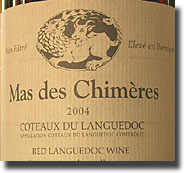 Our
experience with Mas des Chimères goes
back to our earliest days of Gang of Pour, so we never mind having
another glass or two of this old friend. Comprised of about 60% Syrah and
rounded out with Grenache and dollops of Cinsault and Mourvedre, it’s a
straightforward offering after the wild and wooly Mas Saint-Joseph, but that’s
not to say it’s insipid or boring in any way, as it delivers rich red and black
fruit flavors and aromas. Very easy to drink and enjoy, and while some preferred
it with the corned beef, I’d opt for the previous selection, but that’s just the
kind of hair pin I am. Find this wine
Our
experience with Mas des Chimères goes
back to our earliest days of Gang of Pour, so we never mind having
another glass or two of this old friend. Comprised of about 60% Syrah and
rounded out with Grenache and dollops of Cinsault and Mourvedre, it’s a
straightforward offering after the wild and wooly Mas Saint-Joseph, but that’s
not to say it’s insipid or boring in any way, as it delivers rich red and black
fruit flavors and aromas. Very easy to drink and enjoy, and while some preferred
it with the corned beef, I’d opt for the previous selection, but that’s just the
kind of hair pin I am. Find this wine
Darina’s Traditional Bread and
Butter Pudding
Quinta do Infantado Tawny Port NV
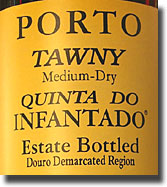 We’re
already fans of Quinta do Infantado Ruby Port, so while we were happy to
try this one and enjoyed it with the delicious bread and butter pudding, I was
so preoccupied with my notes on what Joe was telling us about this producer, I
never did record any impressions of the wine itself. Will it suffice to say that
Kim and I liked it quite well? I guess it’ll have to!
We’re
already fans of Quinta do Infantado Ruby Port, so while we were happy to
try this one and enjoyed it with the delicious bread and butter pudding, I was
so preoccupied with my notes on what Joe was telling us about this producer, I
never did record any impressions of the wine itself. Will it suffice to say that
Kim and I liked it quite well? I guess it’ll have to!
I can tell you this, however: Quinta do Infantado is essentially a “grower Port”
house. It produced the first estate bottled Portos in the Duoro, and was the
first to export them as well; are all (including the Rubies and Tawnies) made
from Class A vineyards (the highest classification), as opposed to the large
shippers who source from Class E and F vineyards for their versions. Or as Joe
Dressner puts it, with the large shippers, Ruby=generic and Tawny=generic, while
with Quinta do Infantado, it’s first class all the way. The reader can find a
far more detailed explanation of just what makes this producer so special here.
Suffice it to say that we like Quinta do Infantado so much, we have to exercise
some restraint in opening them, because they have a tendency to “evaporate”
quickly. Find this wine
It was a great evening, and many kudos to Cloverleaf’s
Putnam Weekley and Tom Natoci for
arranging the affair. Likewise to Baile Corcaigh proprietors
Leo and Sharon Mooney Malinowski for
providing a warm ambience and delicious menus for both carnivores and
vegetarians alike. And of course, many thanks to Joe
Dressner for not only making a rare appearance in Day-twah, but for
doing what he, wife Denyse Louise and
business partner Kevin McKenna do so well,
which is finding and bringing “real wine” to the US, giving wine lovers here a
delicious alternative to the ocean of industrial plonk and overpriced,
manipulated designer foo-foo that permeates the domestic marketplace. Way to go,
Joe!
Reporting from Day-twah,

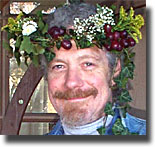
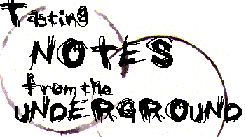

 were in meeting Mr. Dressner, that shameless master of self-promotion. As it
turned out, the food and wine complemented each other quite well, and
camera-averse Joe (at right) was most entertaining and
informative with his informal talks before each course. As we gathered and
renewed acquaintances (there were lots of familiar faces in the crowd), we got
things started with a fine bit of bubbly. (There was a lot going on, so the
following impressions are necessarily of the “snapshot” variety.)
were in meeting Mr. Dressner, that shameless master of self-promotion. As it
turned out, the food and wine complemented each other quite well, and
camera-averse Joe (at right) was most entertaining and
informative with his informal talks before each course. As we gathered and
renewed acquaintances (there were lots of familiar faces in the crowd), we got
things started with a fine bit of bubbly. (There was a lot going on, so the
following impressions are necessarily of the “snapshot” variety.)
 This
medium straw colored wine is made with a mix from
This
medium straw colored wine is made with a mix from

 Jean-Paul
Brun is hardly a household name in most wine circles in the US, but
he is an icon to those who are devoted to “real wine.” Our own
Jean-Paul
Brun is hardly a household name in most wine circles in the US, but
he is an icon to those who are devoted to “real wine.” Our own
 Joe
calls this Loire Pinot Noir “a curiosity and a rarity in America,” and I have to
admit, it’s only the 2nd one I’ve ever tried. It’s not a complex wine, nor is it
intended to be, with middleweight strawberry and tart cherry flavors underscored
with some subtle minerality. Raised in foudre, this is quintessential bistro
wine, being eminently quaffable, although a few tasters were only lukewarm
towards it.
Joe
calls this Loire Pinot Noir “a curiosity and a rarity in America,” and I have to
admit, it’s only the 2nd one I’ve ever tried. It’s not a complex wine, nor is it
intended to be, with middleweight strawberry and tart cherry flavors underscored
with some subtle minerality. Raised in foudre, this is quintessential bistro
wine, being eminently quaffable, although a few tasters were only lukewarm
towards it.  Dressner
says that this wine doesn’t come from a great site, but that the talented
Dressner
says that this wine doesn’t come from a great site, but that the talented
 Côtes-de-Duras,
a large appellation with 2200 hectares of vines (5500 acres) could be considered
a satellite of Bordeaux or Cahors, though it makes mostly forgettable wines
targeted for supermarket sales in France. Catherine
and Jean-Mary Le Bihan are apparently among
the exceptions to that rule, as this wine demonstrates. It’s a red Bordeaux
blend from 20 to 30 year old vines with a lot of Malbec in it, aged in oak, but
not new oak. There was some discussion between those seated at our table and the
next as to whether the somewhat funky quality that this displays is due to
Brettanomyces or not, but whatever the case, it is a little poopy when first
poured, with a solid core of earthy black fruit that’s a little bit spicy. It
also pairs well with the beer stew.
Côtes-de-Duras,
a large appellation with 2200 hectares of vines (5500 acres) could be considered
a satellite of Bordeaux or Cahors, though it makes mostly forgettable wines
targeted for supermarket sales in France. Catherine
and Jean-Mary Le Bihan are apparently among
the exceptions to that rule, as this wine demonstrates. It’s a red Bordeaux
blend from 20 to 30 year old vines with a lot of Malbec in it, aged in oak, but
not new oak. There was some discussion between those seated at our table and the
next as to whether the somewhat funky quality that this displays is due to
Brettanomyces or not, but whatever the case, it is a little poopy when first
poured, with a solid core of earthy black fruit that’s a little bit spicy. It
also pairs well with the beer stew.  This
Rhône estate is a one-plot, 18 hectares operation that produces Syrah (more than
is common locally), Grenache and Carignan, with vines that average 30 years of
age. It didn’t give me much at all on the nose, although Kim mentioned a little
pine and sweaty arm pit, and she was on to something, because the deep, dark
black fruit flavors showed a definite piney undertone and even some earthy
boxwood and cat pee. (Kim and Jim B. both agreed with me in that regard, so if
I’m crazy, it was contagious that evening.) An interesting wine that displays
some of the more extreme characteristics that can be occasionally found in
Syrah-dominated wines, and yes, it really did work with the corned beef and
cabbage!
This
Rhône estate is a one-plot, 18 hectares operation that produces Syrah (more than
is common locally), Grenache and Carignan, with vines that average 30 years of
age. It didn’t give me much at all on the nose, although Kim mentioned a little
pine and sweaty arm pit, and she was on to something, because the deep, dark
black fruit flavors showed a definite piney undertone and even some earthy
boxwood and cat pee. (Kim and Jim B. both agreed with me in that regard, so if
I’m crazy, it was contagious that evening.) An interesting wine that displays
some of the more extreme characteristics that can be occasionally found in
Syrah-dominated wines, and yes, it really did work with the corned beef and
cabbage!  Our
experience with Mas des Chimères
Our
experience with Mas des Chimères 